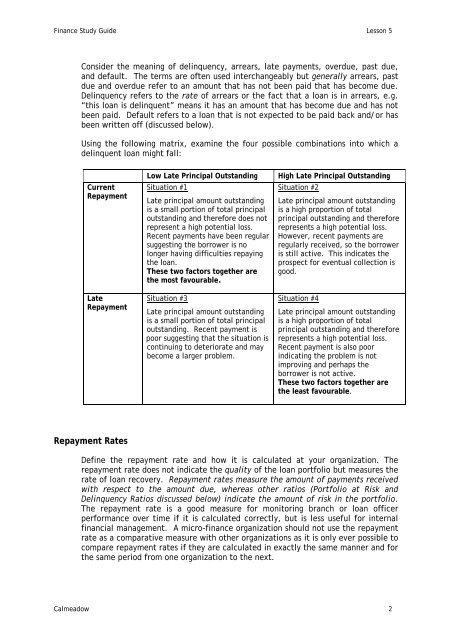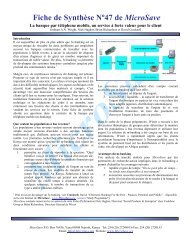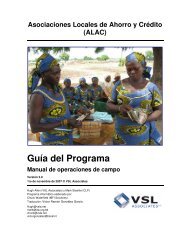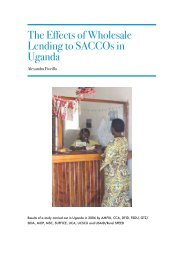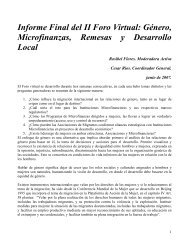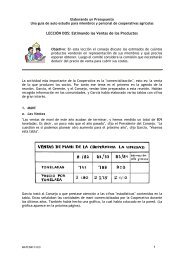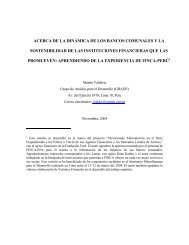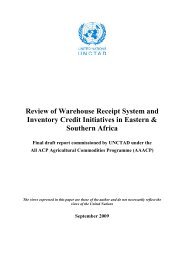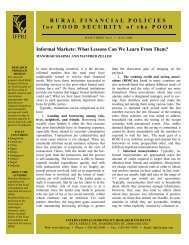Finance - Rural Finance Learning Center
Finance - Rural Finance Learning Center
Finance - Rural Finance Learning Center
You also want an ePaper? Increase the reach of your titles
YUMPU automatically turns print PDFs into web optimized ePapers that Google loves.
<strong>Finance</strong> Study Guide Lesson 5<br />
Consider the meaning of delinquency, arrears, late payments, overdue, past due,<br />
and default. The terms are often used interchangeably but generally arrears, past<br />
due and overdue refer to an amount that has not been paid that has become due.<br />
Delinquency refers to the rate of arrears or the fact that a loan is in arrears, e.g.<br />
“this loan is delinquent” means it has an amount that has become due and has not<br />
been paid. Default refers to a loan that is not expected to be paid back and/or has<br />
been written off (discussed below).<br />
Using the following matrix, examine the four possible combinations into which a<br />
delinquent loan might fall:<br />
Current<br />
Repayment<br />
Late<br />
Repayment<br />
Repayment Rates<br />
Low Late Principal Outstanding High Late Principal Outstanding<br />
Situation #1<br />
Situation #2<br />
Late principal amount outstanding<br />
is a small portion of total principal<br />
outstanding and therefore does not<br />
represent a high potential loss.<br />
Recent payments have been regular<br />
suggesting the borrower is no<br />
longer having difficulties repaying<br />
the loan.<br />
These two factors together are<br />
the most favourable.<br />
Situation #3<br />
Late principal amount outstanding<br />
is a small portion of total principal<br />
outstanding. Recent payment is<br />
poor suggesting that the situation is<br />
continuing to deteriorate and may<br />
become a larger problem.<br />
Late principal amount outstanding<br />
is a high proportion of total<br />
principal outstanding and therefore<br />
represents a high potential loss.<br />
However, recent payments are<br />
regularly received, so the borrower<br />
is still active. This indicates the<br />
prospect for eventual collection is<br />
good.<br />
Situation #4<br />
Late principal amount outstanding<br />
is a high proportion of total<br />
principal outstanding and therefore<br />
represents a high potential loss.<br />
Recent payment is also poor<br />
indicating the problem is not<br />
improving and perhaps the<br />
borrower is not active.<br />
These two factors together are<br />
the least favourable.<br />
Define the repayment rate and how it is calculated at your organization. The<br />
repayment rate does not indicate the quality of the loan portfolio but measures the<br />
rate of loan recovery. Repayment rates measure the amount of payments received<br />
with respect to the amount due, whereas other ratios (Portfolio at Risk and<br />
Delinquency Ratios discussed below) indicate the amount of risk in the portfolio.<br />
The repayment rate is a good measure for monitoring branch or loan officer<br />
performance over time if it is calculated correctly, but is less useful for internal<br />
financial management. A micro-finance organization should not use the repayment<br />
rate as a comparative measure with other organizations as it is only ever possible to<br />
compare repayment rates if they are calculated in exactly the same manner and for<br />
the same period from one organization to the next.<br />
Calmeadow 2


